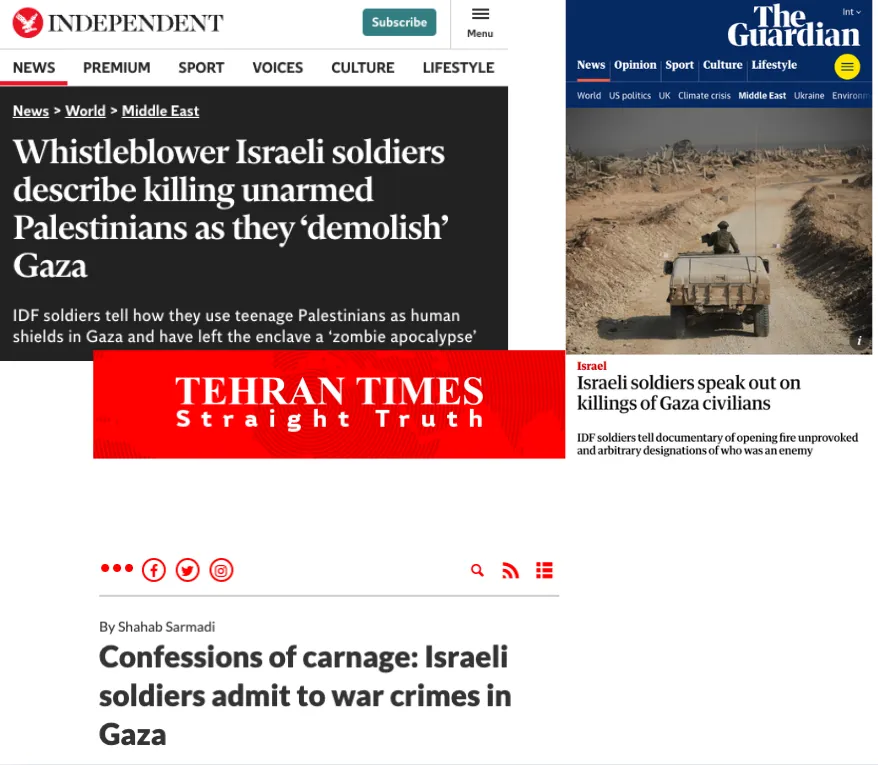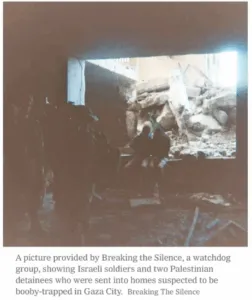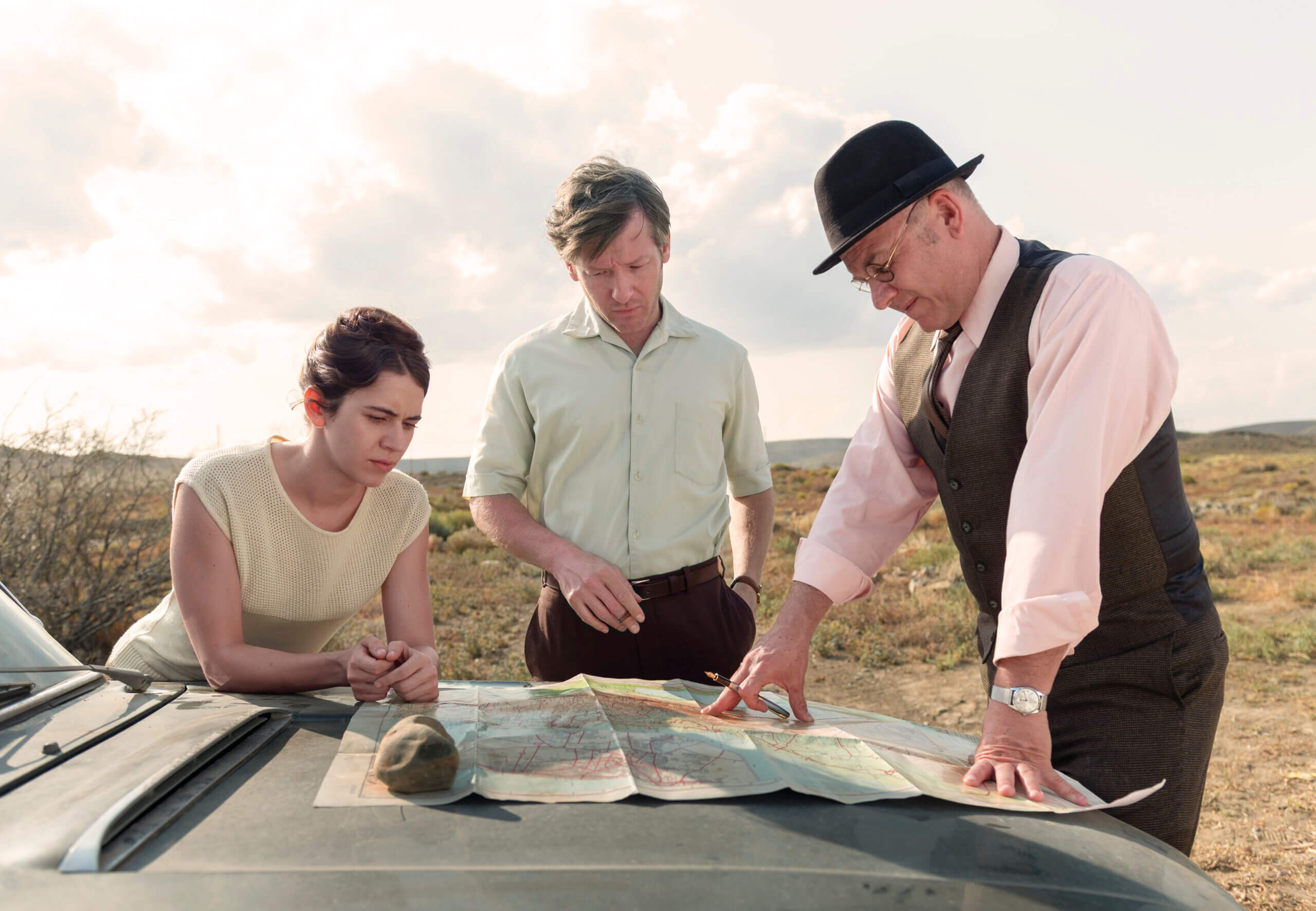Uncategorized
ITV’s ‘Breaking Ranks’: The IDF Soldier Documentary That Broke From the Truth

Then-IDF Chief of Staff Lt. Gen. Herzi Halevi, center, speaking to commanders and soldiers in the Golan Heights on Dec. 13, 2024. Photo: IDF.
A new documentary airing on ITV, Breaking Ranks: Inside Israel’s War, claims to be “the story of the war in Gaza told by the soldiers who fought it.”
An insider account of war sounds promising, especially amid the flood of misinformation online from people who were never on the ground as IDF soldiers and have no experience of the reality of fighting a terrorist organization.
Yet, of all the thousands of soldiers, both in mandatory service and reserve duty, the documentary presents a carefully selected handful of soldiers to tell the story of what they believe really happened in Gaza.
But the story they tell distorts — if not entirely omits — key facts. The film overlooks the reality of what it means to fight a terrorist organization driven by an ideology of extermination, one that deliberately embeds itself among civilians to wage war from within their communities.
That didn’t stop other media outlets from jumping on allegations of war crimes, with outlets such as The Guardian and Independent publishing pieces based on the documentary’s conclusions. That the Tehran Times gleefully pounced on it as well tells a story in itself.

The War Against Hamas
While the film does spend a few minutes showcasing the horrific tragedies of the October 7, 2023, massacre led by Hamas, it quickly shifts its focus to alleged atrocities committed by the IDF in the aftermath.
From the very beginning, the IDF made it explicitly clear that the war was against terrorist organizations only – there was no deliberate targeting of innocent civilians in Gaza. The IDF has maintained this throughout the war, taking every measure possible to warn the civilian population of any potential danger, including sending leaflets before a targeted strike and creating civilian zones to ensure the safety of non-combatants.
The complexity of fighting a terrorist organization is largely overlooked throughout the film. At one point, the use of force in Gaza is called “unprecedented in combat in terms of the number of explosives dropped per square mile,” making it out to be worse than the bombings of Hiroshima and Nagasaki. What it fails to acknowledge is that Israel precisely targets terrorists and terrorist infrastructure.
That viral cartoon comparing Gaza to Hiroshima and London is seriously misleading. Designed to provoke outrage, the reality shows Israel’s precision in targeting terrorists, even in the toughest situations. Context matters. pic.twitter.com/rxvi2YBvl2
— HonestReporting (@HonestReporting) December 14, 2024
Of course, for the documentary to accurately acknowledge the terrorist infrastructure in Gaza, it would have to spend a considerable amount of time discussing the vast tunnel network Hamas has built beneath the entirety of the Gaza Strip. However, this undeniable fact gets quickly glossed over. The filmmakers suggest the tunnels are merely used for “smuggling, warfare, and to avoid Israeli airstrikes.”
This framing subtly shifts blame onto Israel, as if Hamas’s need to “avoid” the Israeli air force is a defensive response rather than a deliberate strategy to wage war from beneath civilian areas. Terrorism? The inhumane holding and torture of hostages in clear violation of every facet of humanitarian law? Entirely unmentioned.
Breaking the Silence
The omission of the true purpose of the tunnels instead becomes spun into a claim based on hearsay that the IDF uses human shields in Gaza. Despite the IDF’s unequivocal denial of such allegations, this assertion is amplified by the interviewees.
However, this should come as no surprise, as one of the interviewees, under the name “Yaakov,” has previously espoused this claim to the New York Times via Breaking the Silence. This highly politicized Israeli organization spends less of its time trying to convince the Israeli public of its case and more on providing the foreign media with fodder to attack Israel.
While the organization seeks to “expose the public to the reality of everyday life in the Occupied Territories,” in reality, it relies on unverified and exaggerated claims provided by IDF soldiers, some of whom receive a paycheck from the organization and therefore may very well have ulterior motives.

“Yaakov” shared photos he took during his time in reserve duty in Gaza, including one now infamous photo that was previously shared in his New York Times article. The photo is said to display civilians who are used as human shields by the IDF when exploring the tunnel network. But the blurry and contextless image offers no evidence whatsoever to support such a serious accusation.
The credits of the documentary give special “thanks” to “Yaakov” from Breaking the Silence, revealing a clear bias in its sources in order to frame a specific narrative about the IDF as a whole. Instead of drawing on a range of credible voices – including a wide array of active-duty soldiers, independent analysts, and military experts – they elevate a figure tied to a controversial advocacy group with a record of misrepresentation.
Amplifying Non-Neutral Voices
“Yaakov” from Breaking the Silence is not the only biased source. Dr. Itamar Mann, a professor of international law at Haifa University, for instance, gives highly critical commentary on the IDF’s actions.
Dr. Mann is listed as an author and legal consultant on a report by Physicians for Human Rights (Israel), claiming there is genocide in Gaza. The organization has been known to spread false, distorted narratives as a way of delegitimizing Israel. In fact, in the immediate aftermath of October 7, the organization stated that it is our “human obligation to contextualize yesterday’s violence.”
The documentary also brings in Amjad al-Shara, the director of the Palestinian NGO Network (PNGO), who refers to the IDF as the “occupation forces,” and is himself described as a “pro-Hamas” figure. PNGO has in the past supported terrorism and hosted conferences or speakers connected to the PFLP.
False Casualty Statistics and Disproved Claims
With the poor sourcing and reliance on problematic organizations, it is no surprise that the documentary also fell into the trap of repeating already thoroughly debunked claims about casualty statistics, genocide, and famine in Gaza.
At one point, the film refers to a previously debunked statistic from a so-called study by The Guardian and +972 Magazine, which claims that 83% of all casualties in Gaza are women and children. This figure is based on data from the Hamas-run Ministry of Health, creating a misleading comparison to the IDF’s confirmed count of 8,900 identified terrorists. By subtracting that number from Hamas’ unverifiable total of 53,000 casualties at the time, these outlets and the documentary falsely present the remaining 83% of casualties as civilians, echoing Hamas propaganda.
Naturally, given the bias of the documentary, the claims of genocide and famine are also leveled against Israel. Even though the definitions of both terms have been distorted in order to accuse Israel of such atrocities, the film presents these allegations as fact, rather than propaganda.
Final Gaza fake “famine” analysis: IPC declared famine on Aug 22. Through ceasefire on Oct 10 there should have been 10,000 starvation deaths. But Hamas/UN counted 192 (most if not all with pre-existing conditions). That’s 98% below famine levels. It was always a hoax. 1/ pic.twitter.com/jWcZOnwdAe
— Aizenberg (@Aizenberg55) October 21, 2025
For a documentary to do its job and remain neutral on such serious allegations, the contrary evidence must be presented, but throughout the documentary, this was deliberately avoided.
War, especially against a terrorist organization that operates using guerrilla tactics, presents immensely challenging scenarios. In the fog of war, mistakes and errors of judgment can and do happen. But it is also true that the IDF has consistently held its soldiers to the highest of standards, investigating any wrongdoing as it occurs.
It would be naive to suggest that every soldier in the IDF or any other comparable army behaves in an exemplary fashion. In September 2024, The New Yorker published a database of what it said is the “largest known collection of investigations of possible war crimes committed [by the US military] in Iraq and Afghanistan since 9/11—nearly eight hundred incidents in all.”
Some of the alleged crimes include “the case of soldiers raping a fourteen-year-old girl and subsequently murdering her and her family; the alleged killing of a man by a Green Beret who cut off his victim’s ear and kept it; and cruelty toward detainees at Abu Ghraib prison and at the Bagram Air Base detention facility.”
All of this is not to claim that the IDF is necessarily more moral than the American military, although there is certainly a good case to be made. The point is that nobody would condemn the entirety of the U.S. Army as an immoral entity that brings shame to its country despite the behavior of a minority of its troops.
And ultimately, ITV’s documentary relies on a tiny number of Israeli soldiers as “eyewitnesses,” most of whom appear to have a political agenda backed by Breaking the Silence.
Rather than offering an honest insight into the complexities of modern warfare against a terrorist organization, the filmmakers chose a simplified, one-sided narrative of Israel’s supposed aggression. In doing so, ITV’s Breaking Ranks fails the very test it set for itself: to tell the story of the war “through the soldiers who fought it.” Instead, it tells a story already written — one shaped by bias, omission, and a refusal to confront the full truth.
The author is a contributor to HonestReporting, a Jerusalem-based media watchdog with a focus on antisemitism and anti-Israel bias — where a version of this article first appeared.
Uncategorized
Trump-MBS Dealmaking Shaped Gaza Vote at UN, Empowering Hamas, Israeli Analysts Warn

US President Donald Trump greets Saudi Crown Prince and Prime Minister Mohammed bin Salman, during a dinner at the White House in Washington, DC, US, Nov. 18, 2025. Photo: REUTERS/Tom Brenner TPX IMAGES OF THE DAY
This week’s UN Security Council resolution endorsing US President Donald Trump’s 20-point Gaza peace plan was timed to appease Western and Arab governments and deliberately crafted to blur the question of Palestinian statehood in pursuit of broader regional interests, according to Israeli analysts, who warned the move risked empowering Hamas and endangering Israel’s security.
Einat Wilf, a former member of Israel’s parliament, known as the Knesset, said the UN resolution intended to remove the Palestinian question from the headlines but could lay the groundwork for “another Oct. 7,” referring to Hamas’s Oct. 7, 2023, massacre across southern Israel, by repeating the same policy of ambiguity that allowed the Palestinian terrorist organization to regroup under previous ceasefire agreements.
Dan Diker, president of the Jerusalem Center for Security and Foreign Affairs (JCFA), argued the vote was strategically timed to coincide with Trump’s meeting with Saudi Crown Prince Mohammed bin Salman in Washington. The US president sought to pair international endorsement of his 20-point Gaza plan with Saudi commitments toward normalizing relations with Israel. Bin Salman, also known as MBS, told reporters in the Oval Office on Tuesday that he was open to joining the Abraham Accords, a series of US-brokered Arab-Israel normalization agreements, if credible progress toward Palestinian statehood could be demonstrated.
The Trump administration aimed to show that the “pathway to implementing Stage Two of the Gaza plan — which includes the International Stabilization Force and a framework for Palestinian statehood — is already in place,” Diker told The Algemeiner in a phone call. “The goal was to get international sanction through the UN so the White House could silence naysayers who claim the plan is a Trump-Israel conspiracy.”
A new poll conducted by the JCFA ahead of the Security Council vote found that 70% percent of Israelis opposed the creation of a Palestinian state under current conditions, with opposition rising to just under 80% among Jewish Israelis. Even when linked to Saudi normalization, the overwhelming majority (62%) remained opposed.
According to Diker, the UN resolution was largely declarative and would not bring the region closer to a Palestinian state. The real agenda rested with Saudi-US ties, with MBS telling Trump that Saudi investments in the United States would increase to nearly $1 trillion. Palestinian statehood figured mostly as lip service, and while Israel signed on, the Palestinian leadership in the form of the Fatah-led Palestinian Authority has proven incapable of governing its own public, with polling consistently showing Hamas as the preferred choice among Palestinians — both in Gaza and the West Bank.
“It’s an ironic development that the great Western powers pushing for a Palestinian state are essentially strengthening Hamas’s hand as the effective leadership of the Palestinian people following the Oct. 7 massacres,” he said.
Wilf, who recently announced her return to politics with her newly formed Oz party, argued that Washington’s goal is to push the Palestinian issue “off the headlines” long enough to advance its broader Middle East agenda.
“The Abraham Accords are no longer about normalizing relations with Israel,” she said in a briefing with reporters on Wednesday. “It’s basically American shorthand for bringing the Islamic and Arab world into the Western orbit in a more structured way and pulling them as much as possible away from China.”
Wilf warned that while Washington’s approach of “constructive ambiguity — the vague language now anchoring the resolution — may serve its short-term strategic goals for the conflict, it puts Israel at risk. By avoiding clear definitions of what a reformed Palestinian Authority or a de-radicalized Gaza would mean, she argued, the resolution leaves the same loopholes that allowed Hamas to rebuild in the past.
The deeper problem, Wilf argued, is a pervasive Palestinian ideology built on rejecting Jewish sovereignty. Until that changes, efforts toward statehood will remain hollow, a dynamic she summed up as “Schrödinger’s Palestine” — a state when it comes to attacking Israel in international forums but not a state when it comes to taking responsibility for its own actions.
Diker said the tension Wilf described has already become a “built-in collision” between Western diplomacy and Palestinian realities.
“The West is acting in a rather colonialist manner by refusing to note the democratic choice of the Palestinian people,” he said. “Oct. 7 was Hamas’s crowning achievement to ultimately uproot and replace the Fatah-led leadership of the Palestinian street.”
Uncategorized
Iran ‘Has No Choice’ but to Move Capital as Water Crisis Deepens, Says President

People shop water storage tanks following a drought crisis in Tehran, Iran, Nov. 10, 2025. Photo: Majid Asgaripour/WANA (West Asia News Agency) via REUTERS
Iranian President Masoud Pezeshkian affirmed on Thursday that the country “has no choice” but to relocate its capital, warning that severe ecological strain has made Tehran impossible to sustain — even as the regime spends billions of dollars rebuilding its military and nuclear infrastructure and backing its terrorist proxies.
In a televised national address, the Iranian leader renewed his call to relocate the capital, asserting that the deepening crisis has “rendered the city uninhabitable.”
Pezeshkian said Iran’s water, land, and infrastructure systems are under such extreme pressure that relocating the capital is now unavoidable, adding that when the move was first proposed, the government lacked even a minimal budget to pursue it.
“The truth is, we have no choice left — relocating the capital is now a necessity,” he said during his speech.
With parts of the city sinking up to 30 centimeters a year and water supplies dwindling, Pezeshkian described Tehran’s current situation as a “catastrophe.”
He urged government ministries and public officials to coordinate their efforts to avert a grim future for the country.
“Protecting the environment is not a game,” the Iranian leader said.
“Ignoring it is signing our own destruction,” he continued, explaining that Tehran can no longer cope with population growth or the city’s expanding construction.
Among the solutions considered to tackle the crisis, one has been importing water from the Gulf of Oman. However, Pezeshkian noted that such an approach is extremely costly, with each cubic meter costing millions to deliver to Tehran.
Earlier this year, the Iranian regime announced it was considering relocating the capital to the Makran coast in the country’s south, a remote region overlooking the Gulf of Oman, in a bid to ease Tehran’s congestion and alleviate its water and energy shortages.
Advocates of this initiative emphasize its strategic benefits, including direct access to the Indian Ocean and significant economic potential through maritime trade, centered on the port of Chabahar, Iran’s crucial gateway to Central Asia.
However, critics argue that the region is still underdeveloped, fraught with security risks, and unprepared to function as a capital, warning that the move could cost tens of billions of dollars — an amount the country cannot bear amid economic turmoil, soaring inflation, and renewed United Nations sanctions.
Notably, the Iranian regime has focused its resources on bolstering its military and nuclear programs rather than addressing the country’s water crisis, a choice that has left citizens’ needs unmet while advancing its agenda against Israel.
The regime has also spent billions of dollars supporting its terrorist proxies across the region and operations abroad, with the Quds Force, Iran’s elite paramilitary unit, funneling funds to the Lebanese group Hezbollah, in defiance of international sanctions.
According to the US Treasury Department, Iran has provided more than $100 million per month to Hezbollah so far this year alone, with $1 billion representing only a portion of Tehran’s overall support for the terrorist group, using a “shadow financial system” to transfer funds to Lebanon.
Iran also provides weapons, training, logistical support, and political backing to the group along with other proxies, including Hamas in Gaza, the Houthis in Yemen, various militias in Iraq and Syria, and other Islamist entities.
Uncategorized
A shocking true story of Mexico’s Jewish community comes to Netflix

Growing up in Paris, an Italian castle, South Africa at the dawn of its civil rights movement and a kibbutz in the then-new state of Israel sounds like it would be enriching, the project of idealistic parents who wanted their children to see the world and witness history. But that wasn’t exactly how it unfolded for Tamara Trottner, née Salzberg, and her brother Isaac.
Instead, they lived in these locations for three years because they were on the run with their father Leo (Emiliano Zurita), who was being hunted by Interpol for kidnapping his own children. He had taken them to retaliate against his wife, Valeria (Tessa Ia), after she had an affair with his brother-in-law.
Trottner wrote a memoir about the experience and it has been adapted into a gripping and sumptuously-filmed Spanish-language miniseries, No One Saw Us Leave, which recently arrived on Netflix.
In the opening episode, we see a stylish wedding between a young Valeria and Leo, both children of leaders of Mexico City’s small Ashkenazi Jewish community. As she prepares to walk down the aisle, Valeria’s mother tells her she is destined to have “a sheyne lebn” — a beautiful life, in Yiddish — and the crowd dances to “Hava Negila.”

But even at their wedding, there’s little warmth between the two; their marriage is closer to a merger between their two families, and while they don’t hate each other, there’s little mutual understanding — Leo believes Valeria should be the woman of the house, but she is tapped into the burgeoning feminism of the 1960s and wants to get a Master’s degree.
We switch between flashbacks of the pair’s marriage — we see the beginnings of Valeria’s affair, as she dances with her brother-in-law Carlos — and Leo’s international run with his children, Tamara and Leo. Though the children, who begin the voyage aged 5 and 7, constantly ask about their mother, he alternates between telling them that she is coming to join them soon and that she did “something bad” and doesn’t want to see them anymore. In fact, Valeria is searching desperately, and has hired an ex-Mossad agent (Ari Brickman) to aid her in the international hunt.
It’s an emotional and suspenseful story as Leo routinely manages to evade the international police. But the subtle story driving all of the drama is that of the tight-knit Jewish community in Mexico City — even today, only 3% of Mexican Jews marry outside the community — and the interplay of respectability and influence within it.
As part of his retribution against Valeria — and to protect his own reputation as he flees Mexico — Leo spreads a story that his wife was unstable and an unfit mother, even alleging that she had been committed to a psychiatric facility. For at least the first episode of the show, the audience, too, is unsure why Leo has really taken the children, and the story about Valeria seems plausible; we’re not sure who to stand with.
The rest of the Jewish community, too, is unsure; at first, people ice out Valeria and her family as they try to gain information about the children’s whereabouts. The push and pull between two powerful families leaves the community confused and caught in the middle. And after Valeria launches a publicity campaign to clear her name and solicit clues, many of the other leaders worry about the damage to the community’s public image in Mexico, alluding to the European antisemitism they fled from. Leo’s father, meanwhile, is a domineering figure who asserts that his daughter-in-law’s affair is just as bad a blow to the community’s reputation as the kidnapping.

The confusion is helped by the fact that Leo is not presented as a villain; he’s a well-developed character, with his own issues with his marriage and with his overbearing father. An ardent socialist, we see him join an activist group against apartheid while hiding in South Africa, and later, when he flees to Israel, he joins the kibbutz he’d dreamed of, and is embraced for his politics and architectural talents.
(Leo’s time in Israel also gives the audience a window into the kibbutzim of the 1960s, which were still practicing an almost militant form of socialism they have since left behind — children were raised communally and told to call their parents by their first names.)
Eventually, Valeria finds her husband and the children, after checking nearly every kibbutz in the country — we see Kfar Aza, one of the towns destroyed on Oct. 7, get crossed off a list — and Israeli courts order Leo and the children back to Mexico. An end note summarizes the rest of the history: Valeria and Carlos, her affair partner, won and raised the children together, who didn’t see Leo again for 20 years.
Of course, much of the show’s drama is in the obvious: Leo’s flight, the children’s growing realization that their father has been lying to them, Valeria’s desperation. But the quiet conflict between families, the power of reputation — both within the small Jewish community and between that community’s relationship and the broader world — undergird every moment of the story. The power of Jewish community is, ultimately, inescapable.
The post A shocking true story of Mexico’s Jewish community comes to Netflix appeared first on The Forward.


